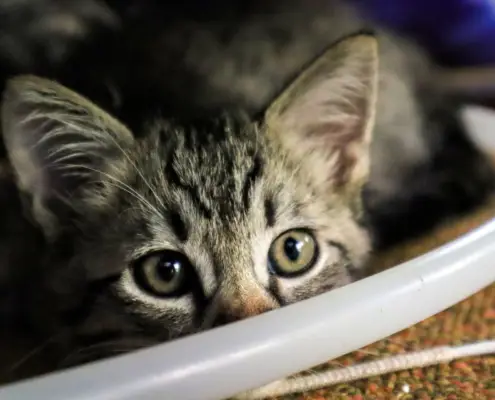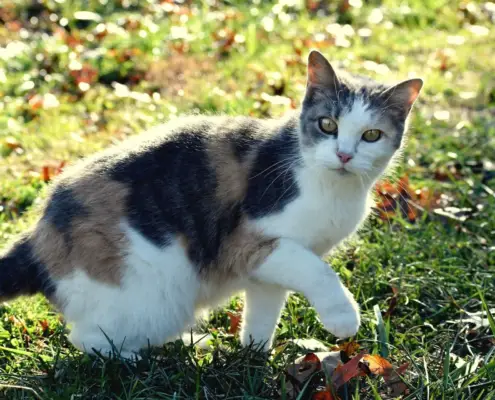
As any cat owner can attest, feline communication is a fascinating and intricate aspect of our feline companions’ behavior. Cats have a unique way of expressing themselves, using a combination of vocalizations, body language, and facial expressions. One such behavior that often leaves cat owners puzzled is the slow blink. In this article, we will delve into the art of feline communication and explore why cats blink slowly.
The significance of blinking in cat behavior
Blinking is a fundamental part of a cat’s communication repertoire. While humans use eye contact to convey emotions and intentions, cats rely on subtle eye movements to express themselves. One of the most intriguing eye behaviors exhibited by cats is the slow blink. When a cat gives you a slow blink, it is a sign of trust and contentment. It is their way of saying, “I feel safe and relaxed in your presence.”
Decoding the slow blink: What does it mean?
The slow blink is often referred to as a “kitty kiss” or a “cat’s smile.” It is a gentle closing and opening of the eyes, which is different from the rapid blinking that occurs when a cat is agitated or fearful. When a cat gives you a slow blink, it is a non-threatening gesture that conveys a sense of calm and affection. It is their way of saying, “I acknowledge your presence, and I feel comfortable around you.”
The science behind a cat’s slow blink
To truly understand the significance of a cat’s slow blink, we must delve into the science behind it. When a cat blinks slowly, they are partially closing their eyes, which reduces the amount of visual input they receive. This action is believed to be a form of self-soothing and a way for cats to regulate their emotions. Additionally, when a cat blinks, it stimulates tear production, which helps keep their eyes moisturized and healthy.
The benefits of slow blinking for cats
Slow blinking serves multiple purposes for cats. First and foremost, it helps them build trust and strengthen their bond with their human companions. When a cat feels safe enough to give a slow blink, it indicates that they have a positive association with the person or environment they are in. Additionally, slow blinking can also help cats establish social hierarchy among themselves. It is a way for cats to communicate their non-threatening intentions and avoid potential conflicts.
How to communicate with your cat through blinking
If you want to communicate with your cat using blinking, the key is to mimic their behavior. When your cat gives you a slow blink, respond by giving them a slow blink in return. This reciprocal blinking can help establish a connection and deepen your bond with your feline friend. However, it is crucial to note that blinking is just one aspect of feline communication. It is essential to pay attention to other forms of body language and vocalizations to fully understand your cat’s emotions and needs.
Common misconceptions about cat blinking
Despite the growing understanding of feline communication, there are still some misconceptions surrounding cat blinking. One common misconception is that a cat’s slow blink is equivalent to a human wink. While a human wink often conveys flirtation or secrecy, a cat’s slow blink is more about trust and relaxation. Another misconception is that all cats blink slowly. While many cats do exhibit this behavior, it is not universal. Some cats may have different ways of expressing their contentment and trust.
Other forms of feline communication
While blinking is an essential part of cat communication, it is not the only way cats express themselves. Cats also communicate through vocalizations such as purring, meowing, and hissing. Additionally, they use their body language to convey their emotions. Paying attention to your cat’s overall posture, tail movements, and ear positions can provide valuable insights into their current state of mind.
Tips for interpreting your cat’s body language
Understanding your cat’s body language can greatly enhance your ability to communicate with them effectively. Here are some tips for interpreting your cat’s body language:
- Tail position: A relaxed and upright tail indicates a content and confident cat, while a puffed-up tail can signify fear or aggression.
- Ear positions: Forward-facing ears demonstrate attentiveness and curiosity, while flattened ears indicate fear or aggression.
- Purring: A cat’s purring can indicate contentment, but it can also be a sign of stress or pain. Observe your cat’s overall body language to determine the context.
- Eye dilation: Dilated pupils can indicate excitement or fear, while constricted pupils can suggest a relaxed and content cat.
By paying close attention to these cues, you can better understand your cat’s emotions and respond accordingly.
Conclusion
Cats are masters of non-verbal communication, and the slow blink is just one aspect of their intricate language. Understanding why cats blink slowly can help us forge a deeper connection with our feline friends and create a harmonious living environment. By reciprocating their slow blink and interpreting their body language, we can communicate effectively and ensure our cats feel safe, loved, and understood.
So, the next time your cat gives you a slow blink, remember that it’s not just a blink—it’s a heartfelt message of trust and affection.
If you enjoyed my article, I would appreciate you sharing it with your network.

Sima Ndlebe
Sima writes for CatBuzz. He is interested in Cats, Health and Fitness, and Entrepreneurship.
Published: 16 November 2023



